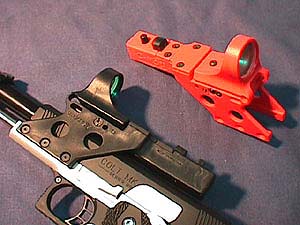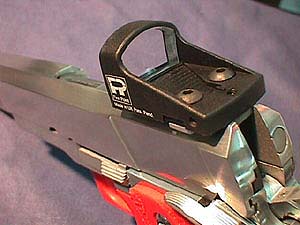

In open class of IPSC, optics can be used. With such assistance,
shooters can gain higher speed and accuracy compared with traditional front
and rear sight. IPSC is always described as an equipment race.
So if you get the most expensive and tech-advance sight, does it means
you have an edge over the others? We will analyse the most popular
optics one by one.
TASCO PROPOINT

The is the earliest generation of red-dot sight used in IPSC.
Out in the market in early 90s, Tasco Propoint II (PDPII) was quickly
adopted as the most popular sight at that time. Top shooter Jerry
Barnhart is one of the shooter who was using it. Tube diameter of
Propoint II is 20mm and it was criticized that field of view is too narrow.
The pure on-off switch caused concern as well. So the Propoint III
(PDPIII) was then released with its problems solved. Tube diameter
is increased to 30mm. Field of view is improved and 11 levels of
light adjustment was added. Latest model Propoint III plus (PDPIIICMP)
was further enhanced on brighter dot and wider field of view with its 33mm
tube.

Shown here is Tasco Propoint III
Good:
Not good:
AIMPOINT COMP
![]()
After model 3000 and 5000, Aimpoint got mature on its Comp model.
With its 30mm tube design and 10 levels of brightness adjustment, COMP
is a serious competitor of Tasco PDPIII. Compared with PDPIII, COMP
is much compact and light, lens is non-reflective and red-dot is bright
enough even in a very sunny day.

Aimpoint Comp in silver colour
Good:
Not good:
C-MORE SERENDIPITY SL

A new generation of optics in IPSC. Tubeless design and ultra
light weight had stunned the industry and competition field. Without
the obstruction of tube, field of view is wider. Light weight of
the sight also helps in fast targeting. Brightness is controlled
by a step-less dial and the dot is bright enough. First edition of C-More
sight was not so rigid as the lens will fall off when seriously shocked.
This problem was certainly corrected, which leaded to the 2nd generation
of C-More.
Serendipity SL model of C-More is popular in its class as it is integrated with frame mount. That saves weight but it is not easy to install in a standard 1911 slide. Such model restricts the height of slide and milling of slide is required. Only a professional gunsmith can do the job.
Dot-searching is another problem for tubeless design optics. As you cannot actually see through a tube in C-More, dot cannot be viewed from incorrect viewing angle. If it is the case, dot cannot only be found until viewing angle is corrected. We call this dot-searching and it happens on Bushnell Holosight and Tasco Optima 2000 as well.

C-More in black and red
Good:
Not good:
BUSHNELL HOLOSIGHT

How can you imagine this generation is coming so fast. After
revolutionary C-More, Bushnell is giving the shooters the Holosight, which
is something very advance. Prototype used by Jerry Barnhart, shooter
and industry was stunned once again after the final version came to market.
Using laser rather than LED light, a reticle is projected to the screen
view by shooter. So the "dot" is no longer a simple dot, but a laser
graphic. Other than that, projected reticle appears to be on the
target with the holography technology used. So acquiring target is
easier. One touch buttons controls and 20 steps of brightness control
further enhance performance of this sight.

Bushnell Holosight with and without frame mount
Good:
Not good:
TASCO OPTIMA 2000
Badged as Optima 2000, this "miniaturized C-More looking" sight is
in fact designed and developed by a British company named Firepoint.
The release of this sight changed the story of Modified Class in IPSC,
as this sight is compact enough to fit into a Modified Class box with proper
installation. Modified class is now including a first optical sight.
Optima 2000 also revolutionizes the carry gun market. As this sight can be permanently switched on for 3 to 4 years (estimated battery life), and compact enough to be daily worn, Optima becomes very popular in the carry gun market as well. This breaks the rule that "Racing optics is never a real life sighting equipment" is proved incorrect. Brightness of dot is automatically adjusted to external lighting environment so no manual adjustment is needed. Mounted on the position of real sight, target is much easier even though the area of viewing is a bit too small.

Shown here is the Firepoint model, sight external
difference distinguishes the two
Good:
Not good:
Making a choice
It can be very easy if you know yourself good enough. Not a single
sight you saw here has absolute advantages over the others. Holosight
may be advance in technology but it is heavy for fast targeting.
Tasco may be heavy but it is free from dot-searching problem. So
before you make a decision, study your shooting and targeting habit.
If weigh affects you, choose a sight which weight less. If finding
a dot concerns you, choose a tube sight. Choosing a sight which suits
you best will give you an edge. Borrow the sight from your friend
and have a look if they got one. This will certainly help you in
arriving a good choice.
If you want to know more on any particular sight, you can see them on the net.